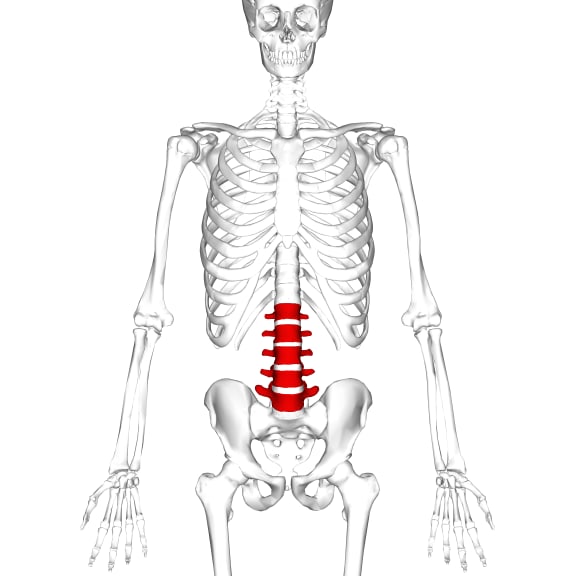By Ruth Beran
The bones of the spine are joined together by little flexible discs which are tough and strong but also flexible. However, if something goes wrong with the discs, it can cause incredible back and lower limb pain.
Professor Neil Broom and his team from the University of Auckland’s Chemical and Materials Engineering department are looking at these discs to better understand their structure and how they interact with the vertebra.

A skeleton, with the lumbar region of the spine (the five lower vertebrae) highlighted in red Photo: Anatomography (CC BY-SA 2.1 JP)
In particular, he’s looking at discs in the lumbar region of the spine, which consists of the lower five vertebrae.
“You have to think of the disc as a kind of squat cylinder with a very strong wall made up of multiple layers,” says Neil. “The internal part is what we call the nucleus, and that looks like a soft jelly. And then round the outside, containing that, is the annulus, which is the really strong part.”
The experiments conducted in the lab are on tissue taken from sheep and when Ruth Beran visited, she discovered that the annulus feels quite solid and fibrous, and looks like tree rings, while the nucleus feels somewhat slimy. Both are white in colour.
PhD student Samantha Rodrigues is looking at how these annular fibres anchor to the bone and the end plate, a transitional region between the disc and vertebra.
“It is a mechanically complex junction,” says Samantha. “You have this change from soft to hard which means that if you’re trying to do anything with the disc it is possible that it can break just because you have that change in properties.”
On the other hand, research fellow Kelly Wade is looking at the disc nucleus.
“When I started, the nucleus was thought of as like this gel. But it’s quite a lot firmer than that.” Kelly Wade
Acccording to Neil, Kelly’s work has shown that the nucleus has a definite structure. “The nucleus is definitely not just a passenger in the disc, it’s there definitely attached to the vertebra,” says Neil.
And because the nucleus has a lot of fluid in it, it gives the disc a lot of resilience under compression .
Given the structural knowledge of spinal discs, Neil and his team are now moving into loading the disc in various postures to see when it is most vulnerable to failure.

From left to right: Neil Broom, Kelly Wade and Samantha Rodrigues with a model of a human spine Photo: RNZ / Ruth Beran
These experiments have shown that flexion (or bending forward) is an issue when loaded and can lead to disc extrusion, and “damage of the nerve fibres, irritation within that region and leading to basically low back pain and certainly lower limb radiating pain which can be extremely distressing,” says Neil.
While it’s difficult to translate laboratory work directly into real-life recommendations, Neil says: “certainly this is warning us, I think, that flexion is potentially dangerous when you overload, and that loading doesn’t necessarily have to be traumatic."
“And if it’s overloading and flexion over a significant period of time, where you’ve got repeated loading, this can lead potentially to problems that cause disc destruction or disc damage,” says Neil.
Video - WARNING: viewers may find this video disturbing
Loading experiment of a sheep’s spine captured on video: First, the disc is put into flexion, and then compressed. We see the disc fail-the wall ripples, accompanied by a twanging, tearing noise, a drop in load and then finally the facet joints fail.

